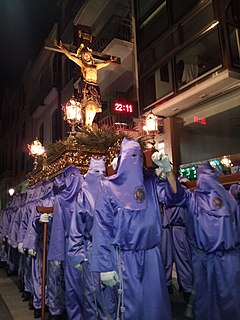Holy Wednesday
| Holy Wednesday | |
|---|---|

Holy Wednesday procession in Villarreal, Spain (2015)
|
|
| Also called | Spy Wednesday Good Wednesday Holy and Great Wednesday |
| Observed by | Christians |
| Type | Christian |
| Significance | commemorates the Bargain of Judas and the Parable of the Two Debtors |
| Observances | Mass; Tenebrae |
| Date | Wednesday before Easter |
| 2016 date |
March 23 (Western) April 27 (Eastern) |
| 2017 date |
April 12 (Western) April 12 (Eastern) |
| 2018 date |
March 28 (Western) April 4 (Eastern) |
| 2019 date |
April 17 (Western) April 24 (Eastern) |
| Frequency | annual |
| Related to | Holy Week |
March 23 (Western)
April 12 (Western)
March 28 (Western)
April 17 (Western)
In Christianity, Holy Wednesday, also called Spy Wednesday, or Good Wednesday (in Western Christianity), and Holy and Great Wednesday (in the Eastern and Oriental Orthodox Churches), is the Wednesday of Holy Week, the week before Easter. It is followed by Maundy Thursday, also called Holy Thursday.
In the New Testament account of Holy Week, after Palm Sunday, the Sanhedrin gathered and plotted to kill Jesus before the feast of Pesach. On the Wednesday before his death, Jesus was in Bethany, in the house of Simon the Leper. As he sat at the supper table with his disciples, a woman named Mary anointed Jesus' head and feet with a costly oil of spikenard. The disciples were indignant, asking why the oil was not instead sold and the money given to the poor. But Judas Iscariot wanted to keep the money for himself. Then Judas went to the Sanhedrin and offered to deliver Jesus to them in exchange for money. From this moment on, Judas sought an opportunity to betray Jesus.
In reference to Judas Iscariot's intent to betray Jesus, formed on Holy Wednesday, the day is sometimes called "Spy Wednesday". (The word spy, as used in the term, means "ambush, ambuscade, snare".)
Although it is sometimes celebrated on Maundy Thursday or Good Friday, the Tenebrae is a liturgy that is often celebrated on Spy Wednesday. The word tenebrae comes from the Latin meaning darkness. In this service, all of the candles on the altar table are gradually extinguished until the sanctuary is in complete darkness. At the moment of darkness, a loud clash occurs symbolizing the death of Jesus. The strepitus, as it is known more probably symbolizes the earthquake that followed Jesus' death: "And, behold, the veil of the Temple was rent in twain from the top to the bottom; and the earth did quake, and the rocks rent". —Matthew 27:51 (AV).
...
Wikipedia
